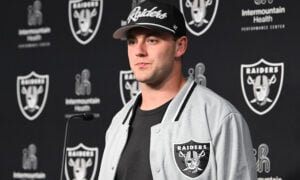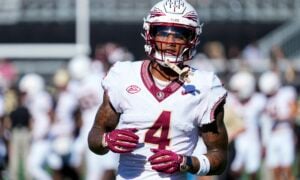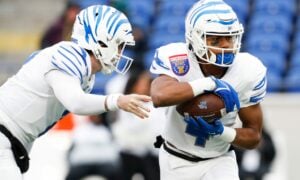The Dynasty Doctor: David Wilson
 In the latest installment of the Dynasty Doctor series, Jeff B asks about the long-term impact of David Wilson’s neck injury, and the likelihood he can return to play in 2014. I thought it would be a good opportunity to delve deeper into Wilson’s neck injury.
In the latest installment of the Dynasty Doctor series, Jeff B asks about the long-term impact of David Wilson’s neck injury, and the likelihood he can return to play in 2014. I thought it would be a good opportunity to delve deeper into Wilson’s neck injury.
Wilson was injured during a week five game against the Philadelphia Eagles, after defensive back Nate Allen hit him in the head/neck region. Wilson was removed from the game and did not return. At first, the injury was downplayed, and called ‘not serious’, and ‘day to day’. Not longer after the injury, he experienced “tingling,” and this suggests injury to a sensory nerve.
Wilson received a second opinion from a renowned orthopedic surgeon, Dr. Robert Watkins. He was then diagnosed with a herniated disc, and Wilson later mentioned his doctors thought he might have spinal stenosis. Dr. Watkins did not recommend surgery for stenosis or the disc herniation, but Wilson was finally placed on injured reserve in November, ending his season. ESPN reporter Adam Schefter reported that doctors told Wilson he faces increased risk of a second neck injury if he continues to play football.
A neck injury that results in neurological symptoms, such as tingling, nerve pain or weakness is called cervical neurapraxia. The most extreme example is quadriplegia, or loss of movement in all extremities. Quadriplegia occurs with damage to motor neurons that control movement from the neck through the rest of the spine. If the cervical spine is severely damaged, complete loss of movement can occur. Fortunately, this extreme injury is rare in the NFL. Nevertheless, it highlights why cervical spine injuries are not trivial.
Wilson’s neck injury is consistent with a cervical neurapraxia, given he had transient sensory abnormalities lasting several days resulting from an impact to his head/neck region, and described disc herniation/spinal stenosis as risk factors for this injury. Spinal stenosis places athletes at risk for cervical neurapraxia as the spinal cord has less space to move when an impact occurs, and is more likely to be damaged from the force of a big hit.
Cervical neurapraxia is most commonly described in contact sports like football, rugby or soccer. This injury might occur with axial loading, and this is when a football player leads with the crown of the helmet, striking another player head-on, otherwise known as “spearing”. Force of spearing is transferred down the spine, followed by hyperextension of the neck. Hyperextension occurs when the neck bends backwards to an extreme degree. Hyperextension results in damage to the spinal cord, as the space surrounding the spinal cord narrows when the neck is bent backwards, and the spinal cord is squeezed or pinched by surrounding bony structures. These bony structures are meant to protect the spinal cord from injury, but ironically these hard surfaces can result in injury to the spinal cord if the neck is bent backwards with great force. Spinal stenosis narrows the spinal canal, and places an athlete at even greater risk of a spinal cord injury, as the amount of space around the spinal cord is tighter than normal.
Cervical neurapraxia injuries are graded based on Torg criteria. Grade 1 injuries have neurological symptoms last less than 15 minutes, grade 2 last 15 minutes to 24 hours, and grade 3 injuries last more than 24 hours. The majority of these injuries are grade 1 in severity.
Surgery can be considered in cases of structural sources of spinal cord compression or if spinal instability is present. One study described five professional athletes who underwent surgery in the cervical spine after sustaining neurapraxia. All five athletes returned to sports, but two of them retired after developing spine problems adjacent to their original injury. This is a common complication of spine surgeries, as the complex movements of the spinal column are inevitably altered after undergoing surgery, resulting in less efficient force displacement and more stress on nearby discs. It was hard for authors of this study to formulate surgical recommendations with such a small sample size, but they concluded athletes could safely return to sport after having a single-level disc surgery and fusion, but with higher risk of re-injury above or below the original level of injury.
Prior episodes of cervical neurapraxia are a risk factor for repeated episodes. One study of 52 athletes with cervical neurapraxia described 62% of them having a second episode. This is particularly important as a second episode may contraindicate return to play, although this is controversial. A second study described 10 athletes with one episode of neurapraxia, and 4 returned to sports without recurrence of this injury, while the remaining 6 athletes retired. A third study evaluated 16 NFL athletes with a history of cervical disc herniations and associated neurological symptoms. 12 players were cleared to play and/or had complete resolution of symptoms (75%), 2 players had persistent symptoms (12.5%), and the remaining 2 players were not seen in clinic. 9 players returned to play football (69%), 4 did not return (25%), and 3 retired after the injury (19%). 13 players were treated non-operatively, and 8 were able to play football again (61%). A fourth study by Hsu described 72% of athletes returning to sport after having surgery for a cervical disc herniation, compared to 46% for those who chose non-operative treatment. A fifth study described 19 rugby players with a single-level fusion surgery for a cervical disc herniation, and 13 were able to play again with resolution of symptoms (68%). I did find a study commenting on four athletes with a cervical spinal cord contusion, and all of them returned to play after having surgery, but two sustained second injuries that led to their retirement from competitive play.
Return to play guidelines are controversial and without consensus opinion. Some authors suggest absolute contraindications include spinal instability, one event with spinal cord damage, more than one episode, or symptoms lasting longer than 36 hours. In general, athletes should have resolution of symptoms, normal strength and full range of motion in the neck without pain to resume playing contact sports. Risk of re-injury is common enough that athletes will likely be told it could occur again and result in more significant injury, as was apparently disclosed to Wilson from his medical team.
Now that we have reviewed the data for cervical neurapraxia and disc herniations/stenosis in competitive athletes, we can draw some conclusions about Wilson’s future in the NFL, and therefore his dynasty value:
- Wilson has a good chance of returning to play next year. In the studies referenced for this article, 40% to 100% were able to return to play after sustaining one episode of cervical neurapraxia.
- Wilson did not have surgery for cervical disc herniation/stenosis, and 40% to 61% athletes who did not have surgery successfully returned to play football. This suggests that athletes who decline surgery for cervical disc herniation/stenosis may be at a slight disadvantage in returning to play.
- Wilson is at risk for re-injury. The largest study of 52 players showed 62% with cervical neurapraxia had a second injury, while smaller studies showed 0-50% with re-injury (both with four players evaluated).
- If Wilson sustains a second episode of cervical neurapraxia, there is a significant risk he may not be able to play again, although this is controversial. Still, a second such injury would put him at risk for no longer playing football.
- Wilson owners have to decide whether to cut their losses and trade him now at a huge discount, or hang on and hope he regains value in 2014. My preference would be to hold onto him, hope he flashes his potential and trade him for maximum value next season. I doubt anyone will give much for Wilson right now. I would be concerned about keeping him long-term, given risk of re-injury, and subsequent complete loss of value. Wilson’s dynasty value is tenuous, but there is hope for resuscitation next season. Just don’t forget to trade him if everyone gets excited about his potential again, as one wrong hit could spell the end of his career.
We do hope Wilson will resume his career and stay healthy long-term. Fortunately, data suggests catastrophic injury is rare, and that is certainly a reason to breathe easier should Wilson take the field again.
References
- Clark AJ, Auguste KI, and Sun PP. Cervical spinal stenosis and sports-related cervical cord neurapraxia. Neurosurg Focus 2011;Volume 31(5):1-5.
- Maroon JC, El-Kadi H, Abla AA, et al. Cervical neurapraxia in elite athletes: evaluation and surgical treatment. Report of five cases. Journal of Neurosurgery 2007;April 6(4):356-63.
- Meredith DS, Jones, KJ, Barnes R, et al. Operative and Nonoperative Treatment of Cervical Disc Herniation in National Football League Athletes. Am J Sports Med 2013;41(9):2054-2058.
- Hsu WH. Outcomes following nonoperative and operative treatment for cervical disc herniations in National Football League athletes. Spine 2011;36:800-805.
- Torg JS. Cervical Spine Injuries and the Return to Football. Sports Health 2009. 1(5):376-83.
- Andrews J, Jones A, Davies PR, et al. Is return to professional rugby union likely after anterior cervical spinal surgery? J Bone Joint Surg Br. 2008;90:619-621.
- Bailes JE. Experience with cervical stenosis and temporary paralysis in athletes. Journal of Neurosurgery 2005;2(1):11-16
- Dynasty Capsule: Carolina Panthers - February 3, 2017
- The Dynasty Doctor: CJ Anderson - January 25, 2017
- The Dynasty Doctor: Week 15 - December 20, 2016


































































